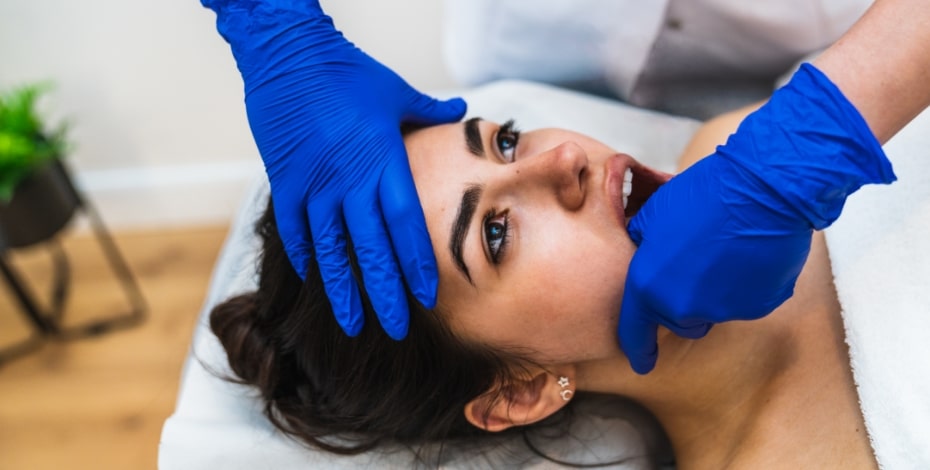
The little-known role of physio in TMD care

Alana Dinsdale is investigating why physiotherapy is under-utilised in the treatment of temporomandibular disorders. Here she talks about her new study, which was recently awarded a PRF Seeding Grant.
Temporomandibular disorders (TMDs) are a group of musculoskeletal conditions affecting the jaw.
People with TMDs can experience significant problems with eating, socialising, working and intimacy due to jaw pain, locking, disturbing joint sounds and fear.
About 10 per cent of the population experiences TMDs during their lifetime and about 15 per cent of cases result in persistent pain and disability.
Physiotherapy is well positioned to deliver first-line management of TMD, which generally involves education, exercise and manual therapy to relieve symptoms and improve function.
However, the unique role of physiotherapists in TMD management is not always understood by people with TMD or first contact healthcare professionals.
This can impact how effectively and efficiently those living with TMDs receive care.
Dr Alana Dinsdale APAM, a physiotherapy lecturer and researcher at the University of Queensland with a clinical interest in TMD, hopes to change that.
Her recent PhD looked at the disabilities associated with TMDs and their management.
During these studies, it became apparent that people with mechanical TMDs (ie, TMDs characterised by jaw clunking, locking and joint sounds with or without pain) found it difficult to navigate the healthcare system to get the care they needed.
‘There was a participant in one study who told me, “I think if there was pain with my condition, it would be a whole lot easier to get help—it’d be a bigger priority for everybody”.
‘I think there’s this perception that if there’s no pain associated with their condition that it’s not impactful, which is just not true,’ Alana says.

Dr Alana Dinsdale APAM is looking at the role of physiotherapy in TMD management.
Alana’s current research program, which was awarded a Physiotherapy Research Foundation Seeding Grant in 2023, builds on her PhD research to explore the role of physiotherapy in the management of TMDs.
The overarching purpose of her research is to improve the management of those seeking care for TMDs within the community.
The initial project will focus on exploring current TMD management practices in Australia and look at what individuals living with TMDs and first contact practitioners currently perceive the role of physiotherapy to be in managing these conditions.
‘We know there’s a huge scope for physios within the TMD space and that our skill set is distinct from that of other healthcare practitioners involved in the multi- disciplinary care of these conditions.
‘We also know that our role, generally speaking, is currently under-recognised and under-utilised within the community.
‘Our team is trying to understand, from the perspective of patients and first contact healthcare professionals, where physiotherapy is perceived to sit in relation to this group of conditions,’ she says.
‘Before we start trying to improve the awareness of the role of physiotherapy in TMD care, it’s important that we understand what our starting point is and what beliefs, perceptions and attitudes patients, physios and other healthcare practitioners have towards it.’
The first part of the study involves a nationwide survey of the attitudes, beliefs and current management practices of first contact healthcare practitioners including GPs, dentists and physiotherapists.
‘We want to know how comfortable these professions feel diagnosing and managing TMDs and what the usual management of TMDs looks like from their perspective,’ Alana says.
In the second part of the study, a selection of practitioners who completed the survey will be interviewed to get a deeper understanding of their beliefs and perceptions regarding the role of physiotherapists in TMD management and to learn more about perceived barriers and enablers within the community.
Alana is hoping for between 10 and 20 practitioners, spanning GPs, dentists and physiotherapists and with representation across metro, regional and rural practices.
A similar set of interviews will be conducted with a group of people living with TMD to get their perspectives.
Again, participants will be selected to include people living with different types of TMD in both metropolitan and regional Australia to get a good cross-section.
‘Based on previous research, we already know that navigating management pathways can be difficult for a lot of people living with TMD.
Because of this, we’ll be diving straight into interviewing people living with TMDs to ask much more specifically about their perceived role of physiotherapy in this space’ Alana says.
The results of the study will underpin a larger ongoing co-design project aimed at developing a consumer-informed strategy to promote the role of physiotherapy in TMD management in the community and improve the management of people living with TMDs.
‘Ultimately it comes back to the patients.
‘The bottom line is that we’re trying to improve management pathways of those seeking care by advocating for the role of physiotherapy and showing the skill set physiotherapists have that might be helpful to those living with TMD,’ Alana says.
COURSE OF INTEREST
Temporomandibular disorders (TMD)— a physiotherapy perspective
© Copyright 2025 by Australian Physiotherapy Association. All rights reserved.





